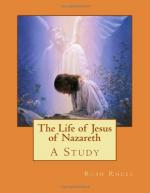189. On Thursday Jesus and his disciples returned to Jerusalem for the last time. Knowing the temper of the leaders, and the danger of arrest at any time, Jesus was particularly eager to eat the Passover with his disciples (Luke xxii. 15), and he sent two of them—Luke names them as Peter and John—to prepare for the supper. In a way which would give no information to such a one as Judas, he directed them carefully how to find the house where a friend would provide them the upper room that was needed for an undisturbed meeting of the little band, and the two went on in advance to make ready. When the hour was come Jesus with the others went to the appointed place and sat down for the supper (Mark xiv. 17; Luke xxii. 14; Matt. xxvi. 20).
190. The gospels all report the last evening which the little company spent together. There is a perplexing divergence, however, between John and the others concerning the relation of this supper to the feast of the Passover. In their introduction of the story, Mark and his companion gospels indicate that the supper which Jesus ate was the Passover meal itself. John, on the other hand, declares that it was “before the feast of the Passover” (xiii. 1) that Jesus took this meal with his disciples. John’s account is consistent throughout, for he states that on the next day the desire of the Jews to “eat the Passover” forbade them to enter the house of the governor lest they should incur defilement (xviii. 28). The other gospels, moreover, hint in several ways that the day of Jesus’ death could not have been the day after the Passover; that is, the first day of the feast of unleavened bread. Dr. Sanday has recently enumerated these afresh, remarking that “the Synoptists make the Sanhedrin say beforehand that they will not arrest Jesus ‘on the feast day,’ and then actually arrest him on that day; that not only the guards, but one of the disciples (Mark xiv. 47), carries arms, which on the feast day was not allowed; that the trial was also held on the feast day, which would be unlawful; that the feast day would not be called simply Preparation (see Mark xv. 42, and compare John xix. 31); that the phrase ‘coming from the field’ (Mark xv. 21 [Greek]) means properly ‘coming from work;’ that Joseph of Arimathea is represented as buying a linen cloth (Mark xv. 46) and the women as preparing spices and ointments (Luke xxiii. 56), all of which would be contrary to law and custom” (HastBD ii. 634). In these particulars the first three gospels seem to confirm the representation of the fourth that the day of the last supper was earlier than the regular Jewish Passover. On the other hand, a strong argument, though one that has not commended itself to other specialists in Jewish archaeology, has been put forth by Dr. Edersheim (LJM ii. 567f.) to prove that John also indicates that the last supper was eaten at the time of the regular Passover. In the present condition of our knowledge certainty is impossible. If John does differ from the others,




